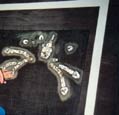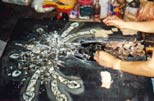Thavibu Contemporary Art from Thailand, Vietnam and Myanmar/Burma
The Process of Making Lacquer Paintings in Vietnam (updated March 2003)
The technique of using lacquer for handicrafts and decorative items in the household has a long tradition in Vietnam since it was introduced from China centuries ago. The French introduced Western paintings and techniques into the country, in particular after the establishment of the Fine Arts University, École des Beaux Art d’Indochine, in Hanoi in 1925. The traditional lacquer technique, which had earlier been used for handicrafts and decorative household items, was now applied to paintings, creating a new art form. The first lacquer paintings were quite traditional in expressing scenes of natural beauty. Later, lacquer paintings promoted socialist and communist values. However, since Vietnam became more outward looking in the 1980s and 1990s, young artists have explored and reinvented the old art form, placing it in a new, contemporary context to create highly innovative and interesting paintings. Each artist has different ways of using lacquer to produce paintings, and some details are known only to the artists themselves. However, there are some features common to all lacquer paintings. Trinh Tuan uses the traditional process described below, but other artists may use modified techniques and even their own innovations..
The Board
The artists buy the boards ready-made from suppliers. They come in a variety of sizes. The core of the board is made from plywood.
One layer of lacquer is applied to the plywood, which is left to dry. Next, thin cotton cloths soaked in clay are attached to both sides of the plywood. After the cotton/clay mixture dries, the board will be smoothed and polished. This process is performed five times. Layers of black lacquer are then applied, and the board is left to dry and is then polished. Thus the final product appears as a piece of black board, very smooth and durable. It consists of several layers, is very resistant, and will not crack due to fluctuations in temperature or humidity. It may warp slightly due to these changes, but it is quite easy to straighten it again, as it remains flexible.
The Lacquer and Colours
Lacquer is a clear sap coming from any of six species of trees growing in Vietnam, the main one being Rhus (or Toxicodendron) succedanea in the north and Melanorrhoea (or Gluta) laccifera in the south, both belonging to the family Anacardiaceae. Lacquer is harvested in the same way as rubber, by making an incision and letting the sap flow. Fresh lacquer is whitish, and turns brown upon exposure to air. It should be noted that lacquer is not a harmless substance. It is a common skin irritant and a cause of contact dermatitis, as well as being potentially carcinogenic. Black lacquer stems from a chemical reaction between lacquer and iron, and results from stirring the lacquer with an iron rod for a few days. Lacquer will be mixed with various natural or artificial dyes to produce the colours the artists want. Several shades of red are extracted from a naturally occurring red mineral, cinnabar (mercuric sulfide). White is produced from eggshell. Eggs from ducks are used because they have a better structure than hens’ eggs. The eggshells are cleaned and sometimes even burned to obtain a brownish tinge. Most bright colours come from artificial dyes.
Other Materials
Several other materials may be used to make lacquer paintings, some of the most common being gold leaf and silver leaf. Silver is used below the layers of colours to create an effect of immense luster. Gold leaf, on the other hand, is often applied as the final layer. An interesting use of gold leaf, as in Trinh Tuan’s painting Contemplation, makes it appear as bright light flowing through the window. A range of other materials may also be used, such as shells, sand, epoxy and clay.
Applying Colours and Polishing
Making a lacquer painting is a long and arduous process. It may take several months, depending on the specific technique of the artist and how many layers of lacquer are included. Here is one example. First, the composition of the painting may be drawn with chalk on the board. White colour is added through the use of eggshell. A pattern is carefully carved out in the board. Minute pieces of clean eggshell are glued to the cavities, and the surface is then made smooth. Clear lacquer is applied and left to dry, and the pattern is then polished.

Fig. 1 Carved pattern on board

Fig. 2 With eggshell, clear lacquer and after polishing
A basic layer of coloured lacquer is applied to the board and left to dry. Silver leaf is stuck to the lacquer and a clear layer of lacquer is applied to cover the silver leaf. New layers of coloured lacquer are painted with a brush, each with different colours. In between, clear lacquer is also applied. The artist sometimes applies up to ten layers or more of coloured and clear lacquer. The painting is left to dry between each application and the layers are also smoothened. The most important part of the process, however, takes place after the final layer has been applied. The artist will polish and rub different parts of the painting until he obtains the preferred colour(s) for various parts of the painting. Since different colours are located in different layers, rubbing must be done with great care by using fine sandpaper and a mix of charcoal powder and human hair. The artist must remember in what layer he put which colour, and has to be extremely careful not to rub too hard because the painting will be irretrievably spoilt if he rubs through the layer he wants to keep. A specific colour nuance can be made by carefully rubbing the interface between two colour layers.

Fig. 3 Drawing the outline with chalk and apply egg shell

Fig. 4 Applying silver leaf

Fig. 5 Applying more silver leaf and paint layers of colours

Fig. 6 Painting more layers of colour and clear lacquer

Fig. 7 Rubbing and polishing
Care
A lacquer painting is very durable. The board is hard and strong and is not easily damaged. The surface of clear lacquer is protective, and the painting can easily be polished by the palm of the hand to make it cleaner and more lustrous. A Vietnamese lacquer painting is truly a piece of art that may last for generations.
Bang Sy Truc
Artist, Art Critic and Art Historian